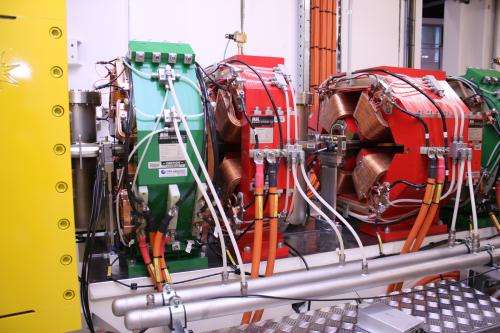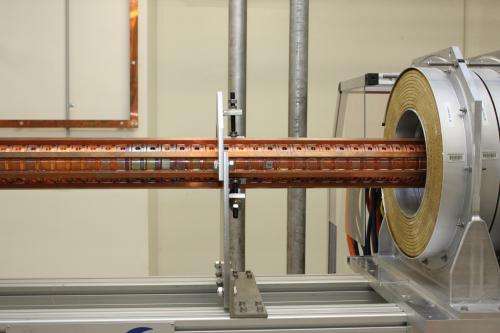An electron's near-light-speed tour of the Australian Synchrotron

There's a place in Melbourne where particles routinely whiz around at 99.99998% the speed of light – the Australian Synchrotron. By accelerating charged particles to release extremely intense light known as synchrotron radiation, the synchrotron gives scientists a mighty toolkit of advanced analytical and imaging techniques.
Depending on the speed of the particles, the radiation released can be infrared, visible or ultraviolet light, or X-rays of varying energy.
So how do these charged particles get to such high speeds? Let's take a look at the synchrotron and its array of super-powerful magnets that accelerate electrons to close to the speed of light.
Synchrotron radiation also exists in nature, notably in the outskirts of the Crab Nebula, 6,523 light-years from Earth, where crowds of electrons travelling at close to the speed of light trace a curved path under the influence of powerful magnetic fields.
Radiation generation
From humble beginnings in the 1940s as an unwanted by-product of particle accelerators, synchrotron radiation has become the power behind numerous practical outcomes of major benefit to Australia.
A good way to explain how radiation is produced when a particle is accelerated is to look at what happens to the electric field around a charged particle when the particle moves.
All charged particles are surrounded by electric fields. Accelerating the charged particle creates fluctuations in the electric field that propagate outwards. As the electric field changes, it in turn generates an associated magnetic field.
These fluctuations manifest as electromagnetic waves which are waves propagated by simultaneous periodic variations of electric and magnetic field intensity. And so an accelerating charge emits electromagnetic radiation, which may include radio waves, microwaves, infrared, visible light, ultraviolet, X-rays or gamma rays. (You can see how the process works using this interactive simulation.)
Synchrotron electrons aren't the only example of accelerating charges emitting electromagnetic radiation. But synchrotron radiation has interesting properties because the electrons are moving at velocities very close to the speed of light.
If you were an electron, you would "see" that you were emitting radiation in all directions. But from the point of view of the mere humans at the synchrotron, relativity means that the radiation is emitted in a very tight forward-facing cone.
Relativity also increases the frequency of the radiation, so most of the light is in the X-ray part of the electromagnetic spectrum, with some ultraviolet, visible and infrared light as well.
The opening angle of the cone of radiation depends on the energy of the electron beam. Higher-energy beams generate cones with smaller opening angles; in other words, tighter cones. These smaller emission angles concentrate the light and make synchrotron radiation extremely bright when seen head-on, which is what most samples get.

An electron's journey
The heart of the Australian Synchrotron is its light source. As used in this context, the term "synchrotron" is in fact short for "synchrotron light source". To an accelerator physicist, a synchrotron is actually a particular type of particle accelerator. But I digress.
At the Australian Synchrotron, the light source is a maze of high-tech equipment that generates bunches of electrons, accelerates them to almost the speed of light and forces them round a curved path to produce light from X-ray to infrared wavelengths for use in scientific and industrial research programs.
The electrons begin their journey in the electron gun, which works a bit like the cathode ray tubes in old television sets.
They're liberated from a metal cathode heated to 1,000C and shot into the linear accelerator in bunches of around 100 million electrons spaced just two nanoseconds apart, travelling at more than 640 million km/h, almost 60% of the speed of light.
The linear accelerator further accelerates the electrons to more than 100 billion km/h or roughly 99.9987% of the speed of light. The radiowave energy used to speed up the electrons comes from a klystron, a type of power amplifier commonly used in radar and radio/ TV broadcasting.
Next is the booster ring, where large electromagnets steer the electron bunches around a near-circular path and control their shape and size. A radiofrequency cavity increases their energy every time they go past.
After 600 milliseconds and 1.38-million laps, the bunches are travelling at 99.99998% of the speed of light and have 30 times the energy they had when they left the linear accelerator.
They're ready to move into their final home, the storage ring, a long stainless steel vacuum chamber that operates at a pressure similar to the moon's atmosphere.
The electrons circulate in the storage ring for approximately 30-40 hours, travelling the equivalent of more than seven laps around the Earth every second.
As they pass through magnets that control their movements, they emit synchrotron radiation, like their counterparts in interstellar space. More radiofrequency cavities add energy to the electrons to compensate for energy lost.

Three main kinds of magnet are colour-coded yellow, green or red according to function:
- yellow dipole (two poles) bending magnets steer the electron bunches and can act as a source of synchrotron radiation
- red quadrupole magnets focus the electron bunches
- green sextupole magnets help correct for focusing errors and steer the beam on the correct path.
Some experiments require more powerful or more highly coherent synchrotron radiation light than the yellow dipoles can produce. For these, specialised magnets called insertion devices are inserted into the line of storage ring magnets.
Insertion devices consist of a large array of small but very strong magnets that either undulate or wiggle the electron bunches as they pass through. Undulators produce highly intense, highly coherent light compared to dipole radiation, while wigglers produce highly intense, higher energy light.
The most powerful insertion device at the Australian Synchrotron is the A$1.3 million superconducting multi-pole wiggler magnet (affectionately called the silver wiggler) that provides X-rays for the imaging and medical beamline.
In the control room
The Australian Synchrotron light source is operated and maintained by specialist control room staff and accelerator physicists. They make sure a consistent and reliable supply of high-quality X-ray and infrared photons is available for the thousands of researchers who use the synchrotron's unique capabilities each year.
The accelerator science team also conducts a research and development program to further improve synchrotron photon characteristics for particular experiments, and contributes to international efforts to pave the way for future machines.
Key results to date include:
- better thermal stability for optical beamline components (from using frequent top-ups to keep an almost-constant number of electrons in the storage ring rather than twice-daily injections)
- a smaller beam with more photons (due to an electron beam with reduced vertical emittance, a measure of the spread of individual particles in a beam) to enable faster data collection from the tiniest of samples, smaller than five micrometres across (one twentieth the width of a typical human hair).
Three years ago the Australian Synchrotron broke the world record for low vertical emittance in an electron beam, with an electron beam that was only a few micrometres high in places, or as fine as spider silk.
That's pretty much the end for the electrons, in the capable hands of the accelerator specialists. But what happens to the light the electrons produce is another story.
Source: The Conversation
This story is published courtesy of The Conversation (under Creative Commons-Attribution/No derivatives).
![]()


















